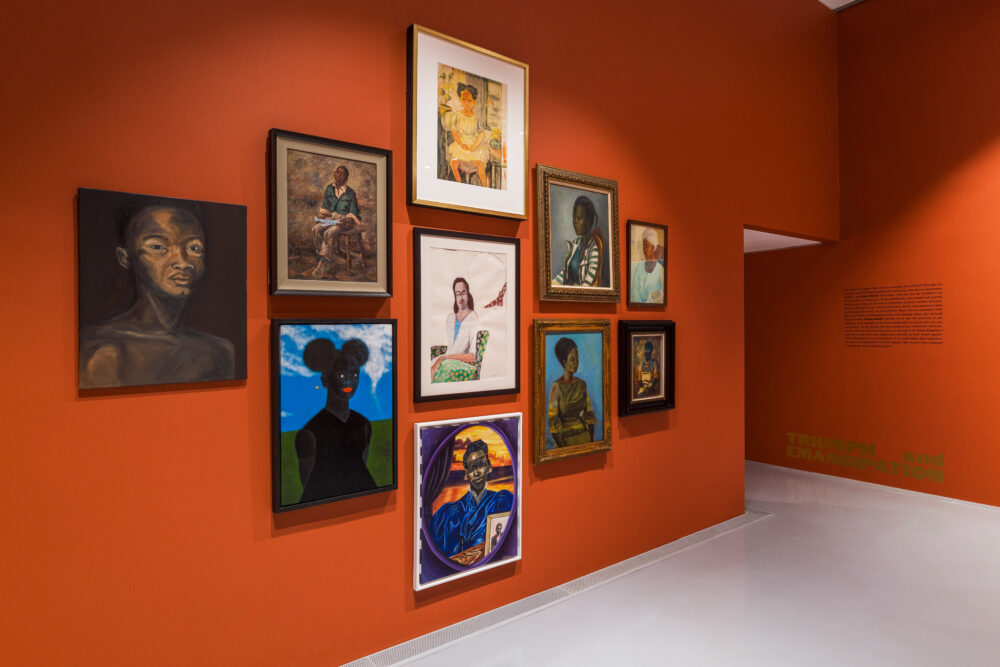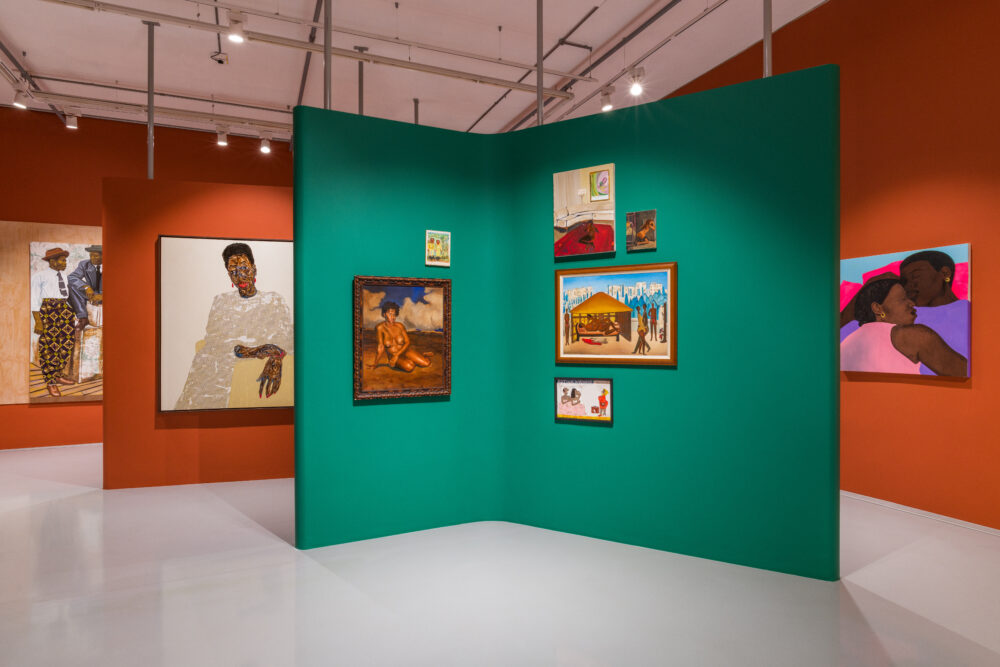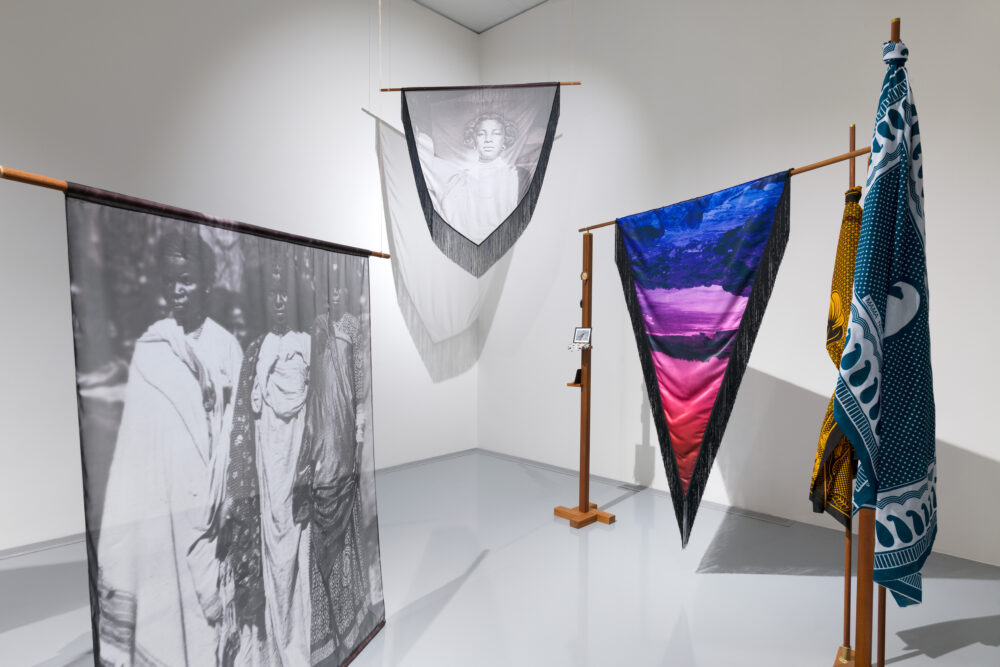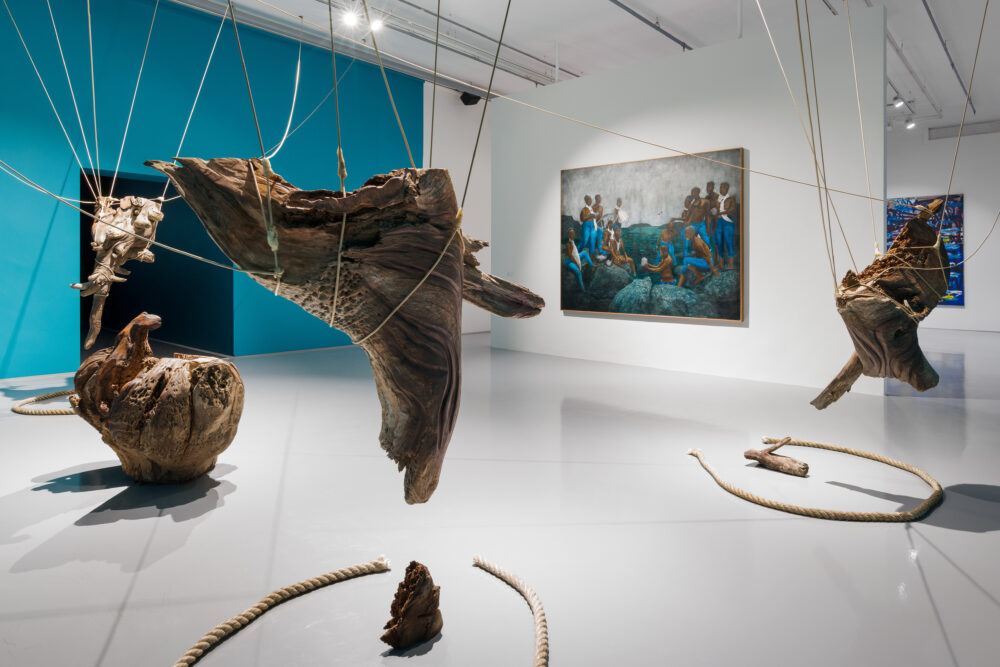Wave goodbye: Cameroonian-Swiss curator Koyo Kouoh, who died of cancer on 10 May, was executive director and chief curator of the Zeitz Museum of Contemporary Art Africa in Cape Town.
This is strange. It’s one of those indescribable feelings. Let me take a few steps black to the future.
No, I’m not referring to the fact that the curator and arts administrator Koyo Kouoh transitioned from this heretofore world hardly a harmattan season whipped astir on the hot fumes of Valentine Yves Mudimbe’s chariot of fire’s zooshing out of planet earth.
It’s not that. It is not that — what is strange is this “thing” of happenstance, if it ever really exists. I’m thinking of Koyo Kouoh, subconsciously reframing her into a past, but when I think deeper, I have the feeling that there was always a “pastness”, not ancient, not post-anything, or pre-that about her.
She vibed off energies of beautiful nostalgia, sometimes melancholia, too, even when photographed decked out in loud psychedelic frocks. And this is the “strangeness”, strange not because she was weird, but because we are usually inadequate to language, a phenomenon of a person whose spirit is logged in the past, yet beams with the outlook and vision ferried by radical futurity. A futurity that can be best described by a tomorrow born of today’s challenges and less of the unexcisable hunchback of history.
Within this Hegellian metaphysical connections, a spirituality of time and place, of things as they are, unencumbered by humanity’s inadequacies to transcend its bodies, its weighty, fleshy needs, its ideologies and rules of living, as opposed to the spectral rot of existence, or the joy of possibility, thinking of Kouoh, is to feel, to love, and to respect Kouoh.
What imbued Kouoh with so much strength and power?
The feeling of thinking about losing Kouoh, and before her Okwui Enwezor and Bibi Silva, renders words inadequate. Mostly because multiple libraries, connections and continuity (one hopes not) are deeply fractured, and threatened by discontinuities, occasioned by these kinds, and these scales, of losses.
Initially, I did not wish to speak about Koyo biographically and mention the obvious solid work she did and continued to do to the very end. So many folks have already done that. And yet I’m compelled to step back into a portrait of her formative years, if only to make sense of her choices later in life.
Koyo Kouoh was born in Douala, Cameroon, in 1967. Though she moved to Zurich when she was 13 and went on to spend more than a decade in Switzerland, studying banking and business administration, her roots were firmly planted back “home” in the continent.
She often spoke of the women in her life, particularly her seamstress grandmother, whose work gave her “access to creativity”; her great-grandmother, who was forced into a polygamous marriage when she was still a teenager.
“My great-grandmother only had her hands and her intellect to raise her four children,” Kouoh told ARTnews. “This is the family I come from. That is the essence of my feminism.” She would later channel that stealthy, African womanism in her life’s work.
It irritates me no end when we in the media, and the arts space as a whole, hang on to neat, flawless narratives as though we are too careful not to disrupt the proverbial donkey cart.
In many testimonies since she passed on we are told a lovely trajectory of a young woman who, inspired by her conversations with Senegalese filmmaker Ousmane Sembène, decided to leave Europe and head back to Africa, Dakar specifically, where she founded RAW Material.
While all that is true, what is missing is the controlled rage. Kouoh had had enough of the European art spaces’ parochialism and exclusion of non-European artists, its insistence on Europe’s modernity, the so-called Enlightenment era, and perceived “civilising” impulse.
She was ready to start the hard work of digging, of rediscovery of African genius. More than anything, as she said in so many interviews, she was concerned with celebrating, debating, championing and exulting in contemporary African art with Africans, for Africans.

 Visionary: The late Koyo Kouoh curated the When We See Us: A Century of Black Figuration in Painting, at the Zeitz Museum of Contemporary Art Africa, in Cape Town.
Visionary: The late Koyo Kouoh curated the When We See Us: A Century of Black Figuration in Painting, at the Zeitz Museum of Contemporary Art Africa, in Cape Town.
The Dakar Kouoh arrived at, in 1995, 20 years after the halcyon days of Étoile star bands, rollicking mbalax, Afro-Cuban merengue, the legendary Orchestra Baobab, Étoile de Dakar, Super Diamono, etc., was indeed impoverished. It was also a cauldron of aesthetic and intellectual ferment, with the percolating energy of 1960s Negritude, fashion and fertile public culture.
This is the Dakar of the Afro-futurist fashion designer Oumou Sy, of the hip-hop movement pioneered by Positive Black Soul, of the artists Issa Samb, and El Hadji Sy, and certainly of my late friend, the bohemian intellectual Djibril Mambety.
The Dakar that drew some of Africa’s most electrifying minds to the think-tank Council for the Development of Social Science Research in Africa, theatre-makers to its stages. As a descriptor of intellectual and creative ferment, the phrase “renaissance” has long been abused. I prefer boiling, ferment, heat. To wit, giving birth as a life-making project.
Kouoh’s work as an innovator, an old-school “community worker”, in that Steve Biko/Mamphela Ramphele zanempilo’s sense of obligation and commitment to communities.
It is a piercing reminder that ultimately art, visual or performance, is not about sashaying in and out of galleries with glass of wine in one hand and a mouse nibble of cheese in the other, or taking Instagram selfies.
Her vision of the power and connectivity, the impulse, of creation is never really about impulse but long-mediated, gestating, about thoughts as well as how environment, as well as dreams, shaped the artist.
In that sense, her curatorial approach and practice were always carried with a bigger purpose than the moment of display itself. See for example her group survey of the history of figuration, and portraiture, When We See Us: A Century of Black Figuration in Painting, at the Zeitz Museum of Contemporary Art Africa in Cape Town.
Kouoh’s curatorial practice always served as a reminder that the chain business of art, from conception to birth, from the gruelling process artists had to walk through to have their work displayed, read and theorised about, understood and misunderstood, was in the main, a matter of life and death.
Throughout her life, Kouoh — like other pioneering women in the culture space such as Bibi Silva, Bongi Dhlomo-Mautloa, the publisher Bibi Bakare-Yusuf, Susana Baca in Peru, the curator-dramatist Wiri Wiri Lekeng, the Wassolou singer Oumou Sangare, the artist Otobong Nkanga — understood that, by committing to do this work the way she did was to put her very life, her very health, on the block, sometimes, the commercial imperatives of the auction block.
She knew deep down that navigating the inconsistencies, as well as the incongruity of accessing the spiritual heft of art, in the extractive business that the art world has become, threw creators and those championing their work into a profound dilemma.
Not only did she put on groundbreaking shows, such as Johannes Phokela’s Only Sun in the Sky Knows How I Feel (A Lucid Dream), she intrinsically knew how to navigate the thorn-strewn path of the art world. Unlike the in-vogue Insta-star curators who have emerged out of nowhere to steal artists’ spotlights — curators with no appetite for the painstaking research, theory and writing work required in addition to administrative nous — Koyo Kouoh knew that art’s glamour is fleeting.
With 35 years of experience as an exhibition-maker and writer, she had the life experience required to subdue her own status in deference to the artists she worked with.

 Koyo Kouoh’s Indigo Waves show at the museum.
Koyo Kouoh’s Indigo Waves show at the museum.
Artists are not the easiest people to work with, even when visionary curators champion them, and why should they be? Their demons and economic woes are insurmountable and often inscrutable. But Kouoh understood that. She understood that the process of making art, as with the collaborative instinct of curatorial work, is gruelling work.
This work — invested with intellectual rigour, community-building, institute-building, shared belief in art as the ultimate saviour of humanity, art as not only a form of resistance but an exploration of joy, of survival, of thriving, art not just political but a spiritual force — all this inevitably takes its toll on the achievers.
Although the official cause of her death, according to a statement by her husband Philippe Mall, was cancer, it is also not unthinkable that her work claimed its pound of flesh. Her curatorial heroes Okwui Enwezor and Bibi Silva and, totally unrelated to the world of visual arts, Busi Mhlongo, along with many other African and black visionaries, succumbed to cancer.
We have to ask ourselves profound questions. Beyond Western science’s theses on ailments such as cancer, is it possible that, as it affects African women and black folks in large numbers, statistically, could it be that cancer is also a somatic ailment of the soul?
Could it be that when our bodies cannot carry the often historical pressure of having to prove oneself 10 times more than others, the pressures that attend the need to validate why we deserve to be in spaces where, not so long ago, we were only appreciated as anthropological displays, curiosity inducing others, and not as agents tasked with staging the research that leads to staging art, the soul simply dumps its unresolved knots karmically into the flesh, in order to survive?
Is survival itself, a spiritually cancer-inducing life process intuited into flesh of the previously enslaved and colonised in disproportionate ways comparative to other creators?
I do not have the answers. What I know, from the experience of having been either the “first black” or “only black” in particular spaces throughout my career, and observing many far more achieving Africans than me, is that cancer manifests itself in multiple ways. Sometimes it colonises your entire being, not in the form of medically diagnosed cancer, but as a cancer of the spirit out to dim and wreak havoc on what the late anthropologist and friend of Jean-Michel Basquiat, Robert Farris Thompson, referred to as “flash of the spirit”.
I met Kouoh quite late in her career, in 2018, at a Goethe-Institut event in Johannesburg. Of course her reputation preceded her, especially as the visionary builder behind Raw Material Company, a Dakar space and communal platform for the development, research, promotion and creation of, as well as discoursing on, contemporary African art.
Kouoh and I had mutual friends. When I saw this woman with red Bamako mud-clay, baby dreads, walking with a stick, visibly in pain but carrying herself regally, and with a sense of purpose, I knew it was Koyo Kouoh. I duly introduced myself by informing her that I was having a legal crisis, as well as crisis of confidence, regarding a major photography show I was working on, Half A Century of Winnie Mandela: In her Own Image.
She looked at me, and into me, and said something I will never forget.
“The fact that you have all these crises means you care enough about her, about this work. Go on and win her heart. The rest will curate itself.”
Which reminded me of George Clinton’s words: “Free your mind, and the ass will follow.”
We remained in touch, bonding and exchanging bon mots and curiosity on everyday life as a repository of as-yet unclaimed archives. The issue which entranced us, in particular, was lit up by my curiosity about a photo of her mother.
Those who were in her phone’s contact list would know that, for a long time, Kouoh had a sepia photo of a beautiful, stylish woman, clad in the sort of “cool”, post-independence African print popular in the Fifties, as her WhatsApp profile pic.
The woman, in what seemed to be a Ghanaian “kaba” blouse, and matching Java print skirt — a look popular in all of post-independence Africa, but not quite free of the long talons of colonialism — radiated freedom. She transmitted the serious gaze that was also de rigueur in the African street studios that pioneered portraiture, from Bamako to Abidjan to Lagos to Bobo-Dioulasso, and beyond, at the time. I was enraptured by this woman.
Is she your grandmother? I ventured. “No, that’s my mother. She understood style as an act of self-affirmation.”
“I’d love to meet her,” I said, in that casual fashion people express themselves privately on secured social media platforms. “She reminds me of my own mother.” To which Kouoh, who anyone who knew her would tell you did not suffer fools gladly, just smiled, and shut off the conversation, with the words, “Talk later, I’m at work. When are you coming to Cape Town?”
I’d be terribly remiss to claim Koyo Kouoh as a personal friend. She was like a big sister I never truly knew. I preferred to engage intellectually but accord her space. Perhaps that’s not always the most generative way of building and sustenance, one learns now via the cruel event of death.
Although we kept in touch, mostly debating art and sharing photos throughout, the last time I saw Kouoh in person was at Zeitz MOCAA, in Cape Town, in 2023. The occasion of our meeting was a pre-exhibition seminar for the group showcase Indigo Waves and Other Stories: Re-Navigating the Afrasian Sea and Notions of Diaspora.
The exhibition — a testament to Kouoh’s commitment to art collectives, collectivity and collaboration among indie-Genius communities, across the world — was a collaboration between Zeitz MOCAA, under Koyo’s stewardship, and Gropius Bau and SAVVY Contemporary, in Berlin, Germany, as well as Vasl Artists’ Association, in Karachi, Pakistan.
The composition of its curatorial team, namely Bonaventure Soh Bejeng Ndikung, Natasha Ginwala, with Michelangelo Corsaro, reflected aspects of the oceanic, ancient searching, surging too, spooling and respooling, telling its historical secrets of the 14th- to 19th-century human trade. Of songs drowned in its belly, of invisible ghosts swimming in tandem with sea creatures, of miscegenation and of love and disbelief encountered in its treacherous waters. From the long stretch of its East African coasts to its Asians, and creolised, archipelagos.
It remains one of the bravest exhibitions in the contested history of hydraulic Africana and Asiana. If the Bandung Conference received its grand gesture of baptism, more than half a century later, this was it.
And this was the reason that the last time I saw Kouoh was on stage, and she was not even there — in essence, she was pixellated within the intangible, but deeply felt stirring notes of waves, waves of sound.
Skin, Senegalese blue. A texture of refined chicory. Swiss chocolate had nothing on her. Teeth glistening with delight. A portrait of a love supreme. I remember it like it was yesterday.
I was holding her tight with both hands, performing some improvised African dance to an a-swirl, notes cascading, soul stirring vocals and the orchestral sweep of Salif Keita’s Tekere, and to cool it down, we dislodged and I left my head, drifted, carried by oceanic vapour as I swayed, as though in a seance, enshrouded within the soaring vocals of the anthem Kono.
In the company of Koyo Kouoh, especially once she had decided to accept you within her circle of spirits, as though she was the spirit conductor, ascension into a trance was possible even in broad daylight. Mostly because she didn’t talk too much. Perhaps she did in the company of those she felt intimately at “home” with. But to some of us distant fellow nocturnal dreamers, her quietude was inviting, never girded in judgment.
Dancing with our heads in the clouds, her frame towering over me rendered the whole thing playful, joyous and in tune with the overall sudden joie de vivre of the day. It was like an emergence. An emergence out of a blue ocean where all the conference attendees seemed to have been submerged, if not for that day, maybe as long as the ocean started drawing our ancestors into it all those centuries ago. It felt like we were in a wake. Instead of sorrow, we danced to Soro.
Ah, ah, ah, to experience joy radiating out of an intellectual and a creator’s pores is something to behold.
We never say this enough about artists, intellectuals and community workers, simply because we have long jettisoned the language of beauty as an intrinsic force enough and, exuberant, within itself.
We talk of beauty in commercial and extractive ways. I need to say it: Koyo Kouoh was a beautiful woman, a beautiful thinker, too.
Consider the following observation on the status of African cultures and the arts, especially half a century post independence: “I am interested in working in making this practice recognised, respected, acknowledged, seen,” she said.
“I do not necessarily think the heightened visibility of African contemporary art is due to a heightened interest in the West.
“It is just due to an increased savviness of African art professionals. There are more professionals in the fields, doing amazing things.
“Ultimately, this is the cause for the attention.”
As a critic, essayist Bongani Madondo won the Film Resources Unit’s Djibril Mambety Award for African Film Criticism. He writes on poetry, photography and politics, and is a photography critic at Conde Nast’s The World of Interiors.